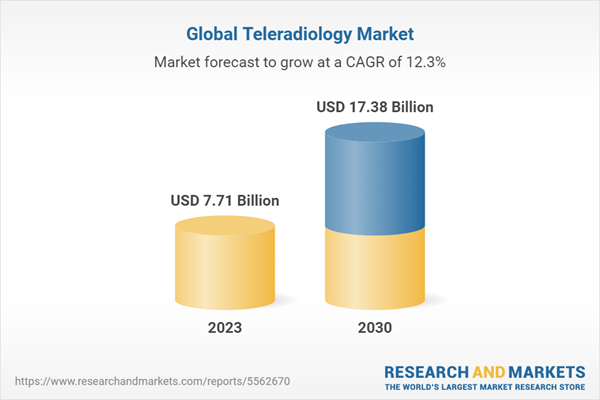Dublin, Jan. 11, 2024 (GLOBE NEWSWIRE) -- The "Global Teleradiology Market, Size, Forecast 2024-2030, Industry Trends, Share, Growth, Insight, Impact of Inflation, Company Analysis" report has been added to ResearchAndMarkets.com's offering.
The Global Teleradiology Market size is expected to reach US$ 17.38 Billion by 2030, with a compound annual growth rate (CAGR) of 12.31% between 2023 and 2030.
The shift from conventional film-based radiography to digital imaging has streamlined the remote transmission and interpretation of clinical images, facilitating steady and active sharing with teleradiologists for timely diagnoses. This transition has been driven by the growing call for radiological offerings, spurred by a growing elderly population and the growing occurrence of chronic ailments. Often, this demand outpaces the supply of on-site radiologists, necessitating teleradiology to bridge the gap. Teleradiology 24/7 availability ensures non-stop access to expert radiological services, vital in emergency and critical care situations where well-timed diagnosis and treatment are paramount.
Moreover, teleradiology networks facilitate connections among healthcare providers and specialized radiologists with information in sectors like neuroradiology or pediatric radiology, enhancing diagnostic accuracy and average patient care. This network additionally permits geographic enlargement, extending radiology services to underdeveloped or remote areas where radiologist shortages are common, thereby broadening access to quality healthcare. Also, teleradiology provides cost-efficiency for healthcare facilities, allowing entry to specialized expertise without the overhead fees associated with full-time radiologist recruits, making it an attractive and economically feasible alternative.
Similarly, governments globally understand teleradiology ability to enhance healthcare accessibility, particularly in underserved areas, leading to supportive rules and policies. The United States Medicare Telehealth Expansion Act of 2000 exemplifies this, extending Medicare insurance to teleradiology services and enhancing accessibility for beneficiaries. Simultaneously, technological advancements, particularly artificial intelligence integration, revolutionize teleradiology. AI streamlines image interpretation, workflows, and diagnostic accuracy, heightening performance. This combination of government backing and technological innovation underscores teleradiology pivotal function in expanding healthcare access and improving diagnostic abilities. Hence, the global teleradiology market size is valued at US$ 7.71 Billion in 2023.

Ultrasound has prominence in the global teleradiology market
Imaging Techniques: Ultrasound prominence in the global teleradiology market results from the growing need for robust healthcare services driven by advances in telecommunication technology. Its non-invasive and radiation-free nature, affordability and portability allow healthcare providers to reach underserved regions efficaciously, and its versatility and effectiveness in diagnostics align with the global trend toward safer and more patient-friendly healthcare solutions.
Ultrasound's non-invasive, radiation-free traits are a favoured diagnostic tool across a broad spectrum of clinical situations, aligning with the worldwide shift toward safer and more patient-centric healthcare solutions. Furthermore, contemporary ultrasound machines, known for their portability and affordability, have amplified their utilization in telemedicine, permitting healthcare companies to attain underdeveloped or faraway regions.
Software is dominant in the global teleradiology market
By Technology: Software prominence in the global teleradiology market may be attributed to numerous vital factors and the simplification of image transmission and interpretation through the digitalization of medical imaging, an essential requirement for remote diagnostics. Also, the software program enables real-time access to patients' facts and photographs, fostering collaboration among healthcare specialists. Artificial intelligence and machine learning advancements enhance software programs' image evaluation capabilities, boosting accuracy and performance. Moreover, software program solutions are price-effective, scalable, and customizable, catering to various healthcare companies. This blend of technological prowess, accessibility, and adaptability solidifies software's preeminent role in the ever-expanding teleradiology services market.
Diagnostic Center is substantially growing in the global teleradiology market
By End-Users: The substantial expansion of diagnostic centres in the global teleradiology service market stems from surging demand for remote healthcare services aided by advanced digital infrastructure and high-speed internet. This permits speedy image and data transfer, even as the combination of AI and machine learning bolsters diagnostic accuracy. Recent years have further increased telehealth adoption, propelling diagnostic centres as safe and efficient healthcare delivery solutions. In this dynamic landscape, diagnostic centres play a pivotal role, broadening access to high-quality clinical diagnostics and fueling the growth of the teleradiology market size.
United States is significantly leading in the global teleradiology market
By Country:The US has continually led the global teleradiology market size because of early adoption, an adequately established healthcare system, high demand for radiologist shortages in faraway areas, and the need for round-the-clock coverage. Government help, exemplified through the Medicare Telehealth Expansion Act of 2000, furthers teleradiology's boom. The US's solid technological infrastructure underpins teleradiology implementation and hosts enterprise leaders like RadNet, Telerad, and vRad, imparting diverse services. Pioneering research and improvement led to modern technology, which includes AI-driven teleradiology systems, improving performance and accuracy.
Key Players
The prominent players in the global teleradiology market include:
- FUJIFILM
- Koninklijke Philips
- General Electric
- Oracle
- Siemens
- GE Healthcare
- McKesson
Imaging Techniques
- X-Ray
- Computed Tomography (CT) Scan
- Magnetic Resonance Imaging (MRI)
- Ultrasound
- Nuclear Medicine
- Others
Technology
- Hardware
- Software
- Services
End User
- Hospitals
- Ambulatory Surgical Centers
- Diagnostic Centers
- Others
Key Attributes:
| Report Attribute | Details |
| No. of Pages | 170 |
| Forecast Period | 2023 - 2030 |
| Estimated Market Value (USD) in 2023 | $7.71 Billion |
| Forecasted Market Value (USD) by 2030 | $17.38 Billion |
| Compound Annual Growth Rate | 12.3% |
| Regions Covered | Global |
For more information about this report visit https://www.researchandmarkets.com/r/wey5xi
About ResearchAndMarkets.com
ResearchAndMarkets.com is the world's leading source for international market research reports and market data. We provide you with the latest data on international and regional markets, key industries, the top companies, new products and the latest trends.
Attachment
